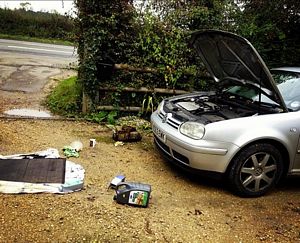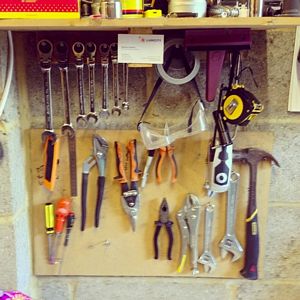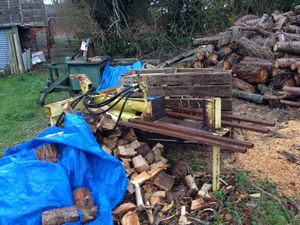|
By accessing/using The Crittenden Automotive Library/CarsAndRacingStuff.com, you signify your agreement with the Terms of Use on our Legal Information page. Our Privacy Policy is also available there. |

The perils of being a home mechanic
|
|---|
|
|
The perils of being a home mechanic
Matt Hubbard
Speedmonkey
March 11, 2013
Instead of paying high labour costs at your local garage why not consider servicing your own car? It saves you money, and you learn new skills. But beware the pitfalls - and pain.
Working on your own car can be an extremely satisfying endeavour. It also has the benefit of saving you money. 50% of a garage bill can be down to labour costs.
The starting point is a Haynes manual. Haynes produce manuals for most cars on the road today, although bizarrely they don't make one for either of my current cars - a V6 Golf and a V8 Discovery.
Once you've started to service your own car you'll soon learn that you can never have enough tools. A good, basic, toolkit or two from Halfords (or Halfrauds as most people who shop there call it) is enough for most minor tasks but then you'll need this wrench and that screwdriver - and an extension to the socket so you can get into the deepest recesses of the engine. And a torx kit. And a bigger socket set. And a ratchet screwdriver set. A home mechanic is never short of ideas when his or her spouse asks what they want for Christmas.
Back to the Haynes manual. As anyone who has used one will know, they look amazingly detailed and easy to use but try actually using one for anything more complex than an oil service and the page turning starts, and goes on and on.
I used to own a Saab 9-3 2.0t. The turbo blew. 'I know', I thought, 'I'll buy one and install it myself'. That was a good idea because a garage would charge £1,800 to supply and install a new one - and the car was worth £2,000. Instead, I bought a used turbo for £600 and fitted it myself.
Now that might sound easy and, to be honest, it looks easy in the Haynes manual. The entire procedure is covered in 20 paragraphs, over 2 pages with lots of pictures. However, delve further into the detail and you will find it is not easy at all. For a start, the pictures never seem to actually relate to the components on the car. To be fair to the authors, the pictures are almost always accurate but are taken at optimal angles, in good lighting. Lying under the car on your driveway looking up at crud encrusted banjo bolts and return pipes with the manual in one hand and a torch in the other, things never seem precisely as they are - so worry sets in. Worry that you're going to undo something that shouldn't be undone.
And then you find you haven't got the right tool for the job. During the two days I took to change the Saab's turbo I went back to the motor factors three times for new tools. For what is now lost in the mists of time but it is often something as simple as a 14mm socket when you've only got a 13mm and 15mm.
Another frustration with using Haynes manuals is that a 20 paragraph process is actually about 60 paragraphs. Paragraph 2 in the Saab turbo change is 'Drain the cooling system - see Chapter 1A'. This turns out to be a 23 paragraph operation. And the list goes on.
Another element of home mechanicing is you quickly learn that a car is made from things that can and will hurt you.
I once changed the petrol filter in a Ford Focus. Looked easy in the Haynes manual. Jack car up, depressurise the system (about 500 paragraphs), undo the retaining bolts, pull the pipes off each end, replace filter, do the reverse. Easy.
It wasn't. The fuel filter in a Focus is nestled in the most inconvenient location since Israel was created in the middle of the Arab states. It is buried in a small gap between the fuel tank and the surrounding bodywork. Armed with a head-torch and some long-reach tools I set about the job. Had the thing free of it's retaining straps in a few minutes. But the pipes wouldn't come off the end.
With no room for manoeuvre I pulled and pulled and pulled until eventually the pipe came off. But there was still some petrol in the system and a jet of it squirted directly into my right ear.
Even now, 4 years later, I remember the pain. I have felt no pain greater in my life, before or since (and I had 20 stitches in my leg with no anaesthetic when I was 10). Petrol in the ear cavity is to be avoided at all costs. Trust me. It went on and on for hours.
But this wasn't as big a disaster as when my friend was changing the oil in his car. He couldn't find an oil catcher so decided to make one. A car's engine will hold 4-5 litres of engine oil so he got an empty 5 litre plastic oil bottle and set about it with a stanley knife to create a flat, open topped oil catcher.
The job started well, but ended badly. The blade slipped. It then travelled across the back of his hand and severed all the tendons. One of them pinged back and ended up under the skin of his knuckle.
Two operations, and twelve months, later and he has regained most of the use of his fingers in that hand.
But neither my ear/petrol pain or my friend's severed tendons can compete with what my father in law did to himself. Whilst not car related this is a lesson to all men who think they can take on machines and win.
Father in law likes to make things himself. He made a contraption called a log splitter (picture below). It saves on all that unnecessary sawing by using a hydraulic ram to smash logs into two pieces. It had so much power it could break an 8 inch diameter log in two - easily. Being a man, and a farmer, it had no safety shields whatsoever.
One day he was using the machine. One hand on log, one hand on the handle. Someone called his name, he turned his head, his hand moved slightly, his other hand slipped on the handle.
The log splitter split his thumb. Or rather it flattened it. I saw it afterwards. It looked like a fifty pence piece.
What, you may ask, is the point of this article? In essence, it is a hearty recommendation to all men and women out there to get out the Haynes manual, buy some tools, open the bonnet and service your own car. It saves you money, can be good fun, is (mostly) satisfying and saves you a whole heap of cash.
But don't forget. If you try and fight machinery, the machinery will win.
N.B. Since the article was written my mechanic friend has injured himself again. He was checking the bearings on a car's wheel. The car was jacked up, he spun the wheel by hand then went to stop it. His finger got caught in one of the spokes, hit the brake calliper and snapped backwards. The finger didn't break even though it was bent back 90°, but the skin tore right across the joint. He said the noise it made was the first clue something was wrong. It made a popping sound. It needed 7 stitches



















 The log splitter
The log splitter
